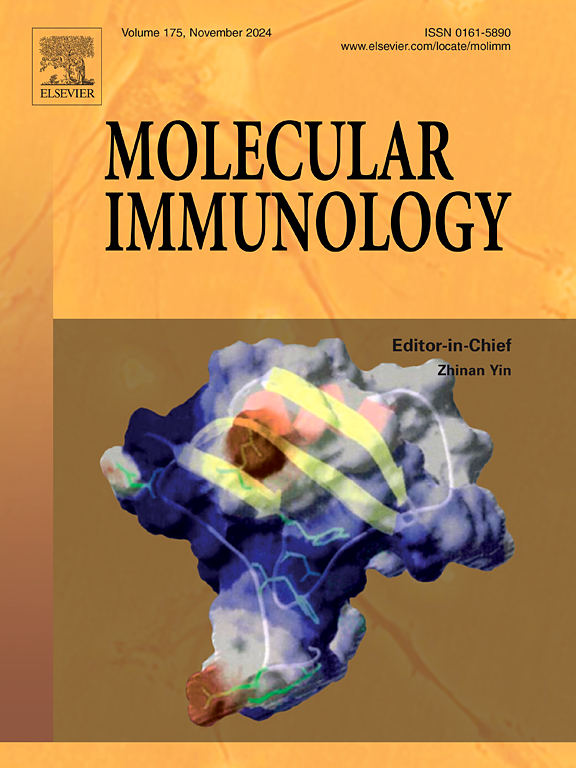Identification of pyroptosis-related gene S100A12 as a potential diagnostic biomarker for sepsis through bioinformatics analysis and machine learning
IF 3.2
3区 医学
Q2 BIOCHEMISTRY & MOLECULAR BIOLOGY
引用次数: 0
Abstract
Sepsis is a non-discriminatory inflammatory reaction that can result in a diverse array of organ dysfunctions, which can be fatal. Pyroptosis is a programmed mechanism of cell death that is distinguishable from apoptosis and other forms of cellular demise. However, the role of pyroptosis in sepsis remains to be further explored. In this study, by employing a combination of the difference analysis, WGCNA, Friends' analysis, and machine learning, the central gene S100A12 was successfully identified. S100A12 demonstrated superb diagnostic capabilities in both the integrated and external validation datasets. Furthermore, significant disparities were observed in the levels of monocytes, eosinophils, and neutrophils between sepsis patients and the control group, as per the findings of immune infiltration analysis. The aforementioned immune infiltrating cells exhibited an increase in expression levels among patients diagnosed with sepsis and were found to be significantly and positively associated with S100A12 expression. The results of the single-cell analysis indicated a significant expression of S100A12 in both neutrophils and monocytes, which was in complete alignment with the outcomes of immune infiltration. In summary, the pyroptosis-related gene S100A12 represents a potential biomarker for the diagnosis and treatment of sepsis.
通过生物信息学分析和机器学习,鉴定热死相关基因S100A12作为败血症的潜在诊断生物标志物
脓毒症是一种非歧视性炎症反应,可导致多种器官功能障碍,这可能是致命的。焦亡是一种程序化的细胞死亡机制,区别于细胞凋亡和其他形式的细胞死亡。然而,焦亡在脓毒症中的作用仍有待进一步探讨。本研究采用差异分析、WGCNA、Friends分析和机器学习相结合的方法,成功鉴定出中心基因S100A12。S100A12在集成和外部验证数据集中都展示了出色的诊断能力。此外,根据免疫浸润分析结果,脓毒症患者与对照组在单核细胞、嗜酸性粒细胞和中性粒细胞水平上存在显著差异。上述免疫浸润细胞在诊断为脓毒症的患者中表达水平升高,并与S100A12表达显著正相关。单细胞分析结果显示,S100A12在中性粒细胞和单核细胞中均有显著表达,这与免疫浸润的结果完全一致。综上所述,热解相关基因S100A12是诊断和治疗脓毒症的潜在生物标志物。
本文章由计算机程序翻译,如有差异,请以英文原文为准。
求助全文
约1分钟内获得全文
求助全文
来源期刊

Molecular immunology
医学-免疫学
CiteScore
6.90
自引率
2.80%
发文量
324
审稿时长
50 days
期刊介绍:
Molecular Immunology publishes original articles, reviews and commentaries on all areas of immunology, with a particular focus on description of cellular, biochemical or genetic mechanisms underlying immunological phenomena. Studies on all model organisms, from invertebrates to humans, are suitable. Examples include, but are not restricted to:
Infection, autoimmunity, transplantation, immunodeficiencies, inflammation and tumor immunology
Mechanisms of induction, regulation and termination of innate and adaptive immunity
Intercellular communication, cooperation and regulation
Intracellular mechanisms of immunity (endocytosis, protein trafficking, pathogen recognition, antigen presentation, etc)
Mechanisms of action of the cells and molecules of the immune system
Structural analysis
Development of the immune system
Comparative immunology and evolution of the immune system
"Omics" studies and bioinformatics
Vaccines, biotechnology and therapeutic manipulation of the immune system (therapeutic antibodies, cytokines, cellular therapies, etc)
Technical developments.
 求助内容:
求助内容: 应助结果提醒方式:
应助结果提醒方式:


